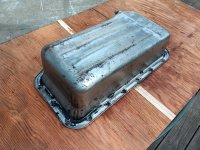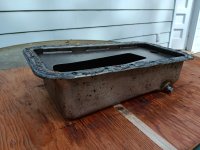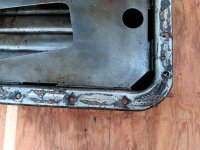RJS
Jedi Warrior
Offline
Hi All
Dropping my oil pan this week mostly to repaint and also to replace the gasket. Back in 2017 I replaced the gasket with a thick cork version. I torqued the bolts to the specified 18 lbs-ft which was probably a mistake. It led to crushing the gasket, resulting in leaks. I used all new hardware, including new bolts, flat washers and lock washers. Used RTV Ultra Back Gasket Sealant to secure gasket to pan first. After that dried in place, I then I used Permatex 2 against the engine block. I seem to consistently have a drip hanging at all four corners of the oil pan and on the drain plug. A few questions/ comments:
Thanks all for bearing with all my questions
Bob
Dropping my oil pan this week mostly to repaint and also to replace the gasket. Back in 2017 I replaced the gasket with a thick cork version. I torqued the bolts to the specified 18 lbs-ft which was probably a mistake. It led to crushing the gasket, resulting in leaks. I used all new hardware, including new bolts, flat washers and lock washers. Used RTV Ultra Back Gasket Sealant to secure gasket to pan first. After that dried in place, I then I used Permatex 2 against the engine block. I seem to consistently have a drip hanging at all four corners of the oil pan and on the drain plug. A few questions/ comments:
- I don't believe I bent the bolt holes but, will re-check the pan for flatness
- I purchased both a stock gasket (~$5) and a "Payen" gasket (~$25) from the "Big M". Any preference/ difference?
- I did not replace the Block Sealing Pads last time. I will this time
- Drain plugs:
- How tight do you make the drain plug? I read that pipe thread can actually be tightened very tight.
- I am using a magnetic drain plug. Any experience with them not sealing completely? I have several stock plugs in the basement
- Does anyone recommend using thread sealant?
Thanks all for bearing with all my questions
Bob

 Hi Guest!
Hi Guest!

 smilie in place of the real @
smilie in place of the real @
 Pretty Please - add it to our Events forum(s) and add to the calendar! >>
Pretty Please - add it to our Events forum(s) and add to the calendar! >> 





